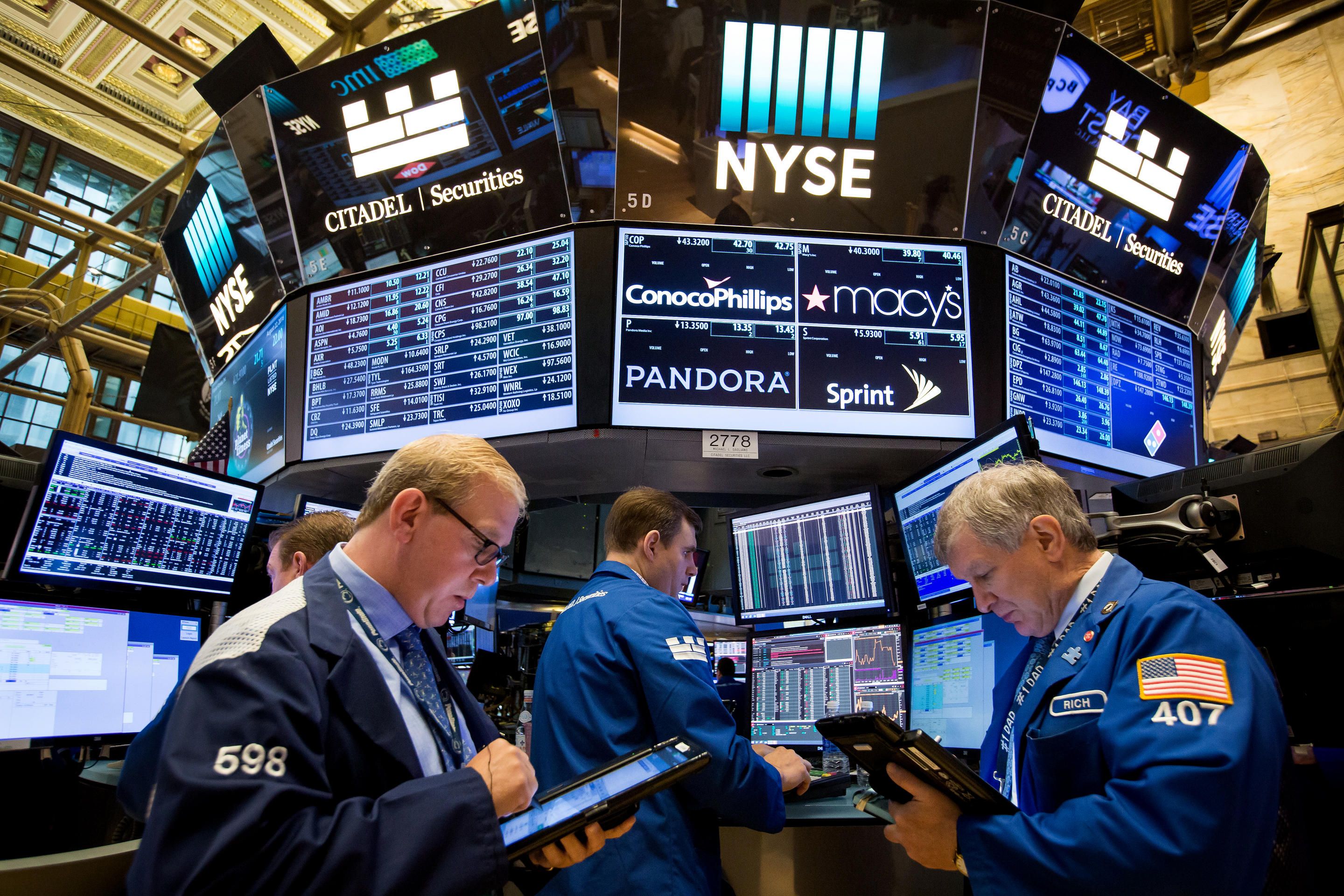Economy
Optimism About More Dovish Fed May Generate Buying Interest

By Investors Hub
The major U.S. index futures are pointing to a higher opening on Wednesday, with stocks likely to add to the gains posted in yesterday?s volatile session.
Traders may once again look to pick up stocks at reduced levels after the markets were unable to sustain the initial upward move in the previous session.
The major averages managed to end Tuesday?s trading in positive territory, although many sectors extended recent sell-offs.
The markets may also benefit from optimism the Federal Reserve will strike a more dovish tone in its announcement of its latest monetary policy decision this afternoon.
The Fed is widely expected to raise interest rates by a quarter point, but traders will closely scrutinize the central bank?s accompanying statement and forecasts for clues about future rate hikes.
Ahead of the announcement, President Donald Trump has been urging the Fed to refrain from its gradual pace of raising rates.
?Don?t let the market become any more illiquid than it already is,? Trump told the Fed in a post on Twitter on Tuesday. ?Stop with the 50 B’s. Feel the market, don’t just go by meaningless numbers. Good luck!?
While the Fed will not want to be seen as bowing to political pressure, the central bank may still signal a slower pace of rate hikes due to recent disappointing economic data, low inflation, and concerns about the ongoing trade dispute between the U.S. and China.
After failing to sustain an early move to the upside, stocks continued to experience substantial volatility over the course of the trading day on Tuesday. The major averages fluctuated wildly as the day progressed before closing in positive territory.
The S&P 500 hit its lowest intraday level in over a year but ended the up just 0.22 points or less than a tenth of a percent at 2,546.16. The Dow rose 82.66 points or 0.4 percent to 23,675.64 and the Nasdaq climbed 30.18 points or 0.5 percent to 6,783.91.
The initial strength on Wall Street was partly due to bargain hunting, with traders picking up stocks at reduced levels on the heels of the sharp drop seen over the two previous sessions.
The pullback seen Monday afternoon pulled the Dow down to its lowest closing level in over eight months, while the Nasdaq and the S&P 500 dropped to their lowest closing levels in over a year.
The subsequent volatility came as traders remained on edge ahead of the Federal Reserve’s monetary policy announcement.
On the U.S. economic front, the Commerce Department released a report showing a substantial increase in U.S. housing starts in November, as a spike in multi-family starts more than offset a continued drop in single-family starts.
The Commerce Department said housing starts jumped by 3.2 percent to an annual rate of 1.256 million in November from the revised October estimate of 1.217 million.
Economists had expected housing starts to edge down to a rate of 1.225 million from the 1.228 million originally reported for the previous month.
The report also said building permits surged up by 5.0 percent to an annual rate of 1.328 million in November from the revised October rate of 1.265 million.
Building permits, an indicator of future housing demand, had been expected to dip to a rate of 1.259 million from the 1.263 million originally reported for October.
Gold stocks showed a substantial move to the upside over the course of the session, driving the NYSE Arca Gold Bugs Index up by 2.3 percent. With the jump, the index reached a four-month closing high.
The rally by gold stocks came amid a modest increase by the price of the precious metal, with gold for February delivery rising $1.80 to $1,253.60 an ounce.
Housing stocks also saw considerable strength on the heels of the housing starts data, moving notably higher along with computer hardware and semiconductor stocks.
On the other hand, energy stocks moved sharply lower amid a steep drop by the price of crude oil. Crude for January delivery plunged $3.64 to a fifteen-month closing low of $46.24 a barrel amid concerns about oversupply.
Oil service stocks turned in some of the energy sector’s worst performances, dragging the Philadelphia Oil Service Index down by 2.7 percent to its lowest closing level in fifteen years.
Tobacco stocks also extended a recent sell-off, while considerable weakness also emerged among biotechnology and banking stocks.
Economy
NGX Crossing N100trn Reflects Renewed Investor Confidence—Popoola, Chiemeka

By Aduragbemi Omiyale
The chief executive of the Nigerian Exchange (NGX) Group Plc, Mr Temi Popoola, and his counterpart at the NGX Limited, Mr Jude Chiemeka, have expressed delight over the value of the bourse breaking the N100 trillion ceiling on Monday.
Yesterday, the domestic stock exchange gained 1.74 per cent, with the market capitalisation rising by N1.869 trillion to N101.807 trillion ($71.15 billion) from N99.938 trillion ($69.61 billion) and the All-Share Index (ASI) growing by 2,725.86 points to 159,218.22 points from last Friday’s 156,492.36 points.
The growth was buoyed by renewed investor demand and broad-based gains across listed stocks, resulting in a year-to-date returns of 2.32 per cent.
It was observed that the rally was driven by strong buying interest in stocks such as Cadbury Nigeria, Fidson Healthcare, and Champion Breweries, reflecting the traditional “January Effect” that often characterises early-year market activity.
Investor sentiment strengthened markedly, with market breadth improving to 9.13x as 73 equities recorded gains against eight decliners, signalling widespread participation in the rally.
“The equities market capitalisation crossing the N100 trillion mark is a defining milestone for Nigeria’s capital market and a clear signal of renewed investor confidence as the year begins.
“It reflects the market’s growing depth, resilience, and ability to respond positively to improving macroeconomic conditions and structural reforms,” Mr Popoola stated, adding that sustained collaboration between market stakeholders and regulators has played a key role in strengthening market credibility.
“Over the past two years, closer alignment between market operators, policymakers, and the Securities and Exchange Commission (SEC) has enhanced transparency, liquidity, and investor protection, reinforcing the Exchange’s role in mobilising long-term capital for economic growth,” he said.
On his part, Mr Chiemeka said, “The breadth of the market tells a positive story. We are seeing strong participation across banking, industrial, and consumer stocks, alongside rising trading volumes, which suggest growing investor confidence and a more active market at the start of the year.”
Economy
2026: NASD Exchange Eyes Inclusive Economic Growth, National Transformation

By Adedapo Adesanya
The Managing Director of the NASD Over-the-Counter (OTC) Securities Exchange, Mr Eguarekhide Longe, has said the bourse in 2026 would play its role in expanding the economic space and anchoring enduring socio-political transformation and inclusive growth in the country.
Speaking as part of his new year message, the NASD helmsman noted that the steady gains recorded in the nation’s macro-economy will translate to further gains in 2026.
“In this regard, we are optimistic about the further structural reforms and gains that will attend the implementation of the Nation’s new tax law.
“We know that there are development gaps to be covered in improving hard and soft infrastructure, as well as supporting genuine entrepreneurs across the length and breadth of the country, providing justification for scaling up projects and businesses via the instrumentality of structured capital market platforms,” he said.
He also said the flagship OTC market performed moderately with new admissions and a consolidation of the staple performers in the trading year 2025.
“2025 has turned out, in many respects, to be a year of reasonably positive performance, financially, but more a year of tangible results from the diversification of the activities on NASD,” Mr Longe said.
Business Post analysis of the bourse’s 2025 Trading Summary showed that the exchange recorded a strong expansion in market capitalisation in 2025, even as overall trading activity by deal count declined compared with 2024.
Market capitalisation on the exchange more than doubled to N2.12 trillion in 2025, representing a 106 per cent increase from N1.03 trillion in 2024. The number of admitted securities also rose marginally to 47, up from 45 in the prior year, reflecting a 4 per cent growth.
The NASD Securities Index (NSI) rose by 18 per cent to 3,543.74 points, compared with 3,002.68 points in 2024. Similarly, the NASD Pension Index advanced by 21 per cent to 1,032.88 points, up from 954.33 points.
Trading volumes surged significantly during the year. Total volume traded climbed to 14.03 billion units, marking a 377 per cent increase from 2.98 billion units in 2024. However, this sharp rise in volume contrasted with a decline in transaction value, which fell by 43 per cent to N59.29 billion, down from N103.96 billion in 2024.
The total number of deals executed on the platform dropped to 6,456, representing a 26 per cent decline from 8,724 deals recorded the previous year, indicating fewer but larger or more strategic transactions.
The exchange also recorded notable listings in 2025, with Infrastructure Credit Guarantee Company PLC (InfraCredit), Paintcom Investment Nigeria PLC (Paintcom), and MRS PLC admitted to trading. In addition, the listing of the Access Bank PLC Rights Issue contributed to market growth. Combined, new listings on the NASD in 2025 were valued at approximately N1.121 trillion.
Commercial Paper admissions unto the NASD platform exceeded N34.32 billion in the trading year and maiden offer on the NASD Digital Securities platform of a tokenised Commercial Paper stood at N5 billion.
Economy
NASD OTC Bourse Soars 0.60%

By Adedapo Adesanya
The trading compass at the NASD Over-the-Counter (OTC) Securities Exchange pointed north on Monday, January 5 after the market closed higher by 0.60 per cent.
The NASD Unlisted Security Index (NSI) added 21.49 points to close at 3,575.33 points compared to the previous session’s 3,553.84 points just as the market capitalisation inflated by N12.86 billion to finish at N2.139 trillion, in contrast to last Friday’s value of N2.126 trillion.
The growth recorded by the NASD OTC bourse yesterday was influenced by three securities led by FrieslandCampina Wamco Nigeria Plc, which gained N4.70 to close at N51.70 per share compared with the previous N47.00 per share.
Further, Geo-Fluids Plc appreciated by 43 Kobo to settle at N6.94 per unit versus N6.51 per unit, and Central Securities Clearing System (CSCS) Plc appreciated by 37 Kobo to N36.00 per share from N35.63 per share.
Data from the alternative stock exchange showed a drop in investor appetite as the volume of trades declined by 94.7 per cent to 193,973 units from 3.6 million units, while the value of transactions decreased by 68.2 per cent to N4.5 million from N14.1 billion, with the number of deals sliding by 34.8 per cent to 15 deals compared to 23 deals.
At the close of business, CSCS Plc was the most traded stock by value on a year-to-date basis with 341,080 units sold for N12.2 million, followed by Geo-Fluids Plc with 535,970 units valued at N3.5 million, and Industrial and General Insurance (IGI) Plc with 2.9 million units exchanged for N1.9 million.
However, IGI Plc was the most active stock by volume on a year-to-date basis with 2.9 million units traded for N1.9 million. trailed by Geo-Fluids Plc with 535,970 units worth N3.5 million, and CSCS Plc with 341,080 units valued at N12.2 million.
-

 Feature/OPED6 years ago
Feature/OPED6 years agoDavos was Different this year
-
Travel/Tourism9 years ago
Lagos Seals Western Lodge Hotel In Ikorodu
-

 Showbiz3 years ago
Showbiz3 years agoEstranged Lover Releases Videos of Empress Njamah Bathing
-

 Banking8 years ago
Banking8 years agoSort Codes of GTBank Branches in Nigeria
-

 Economy3 years ago
Economy3 years agoSubsidy Removal: CNG at N130 Per Litre Cheaper Than Petrol—IPMAN
-

 Banking3 years ago
Banking3 years agoFirst Bank Announces Planned Downtime
-

 Banking3 years ago
Banking3 years agoSort Codes of UBA Branches in Nigeria
-

 Sports3 years ago
Sports3 years agoHighest Paid Nigerian Footballer – How Much Do Nigerian Footballers Earn













